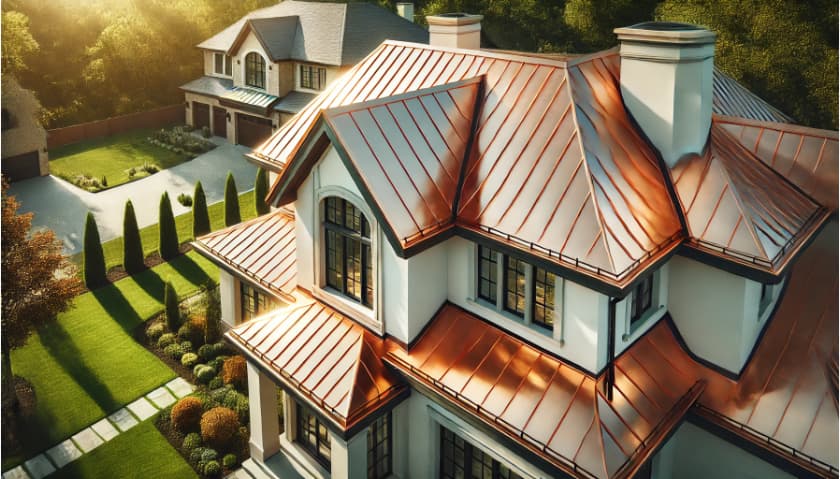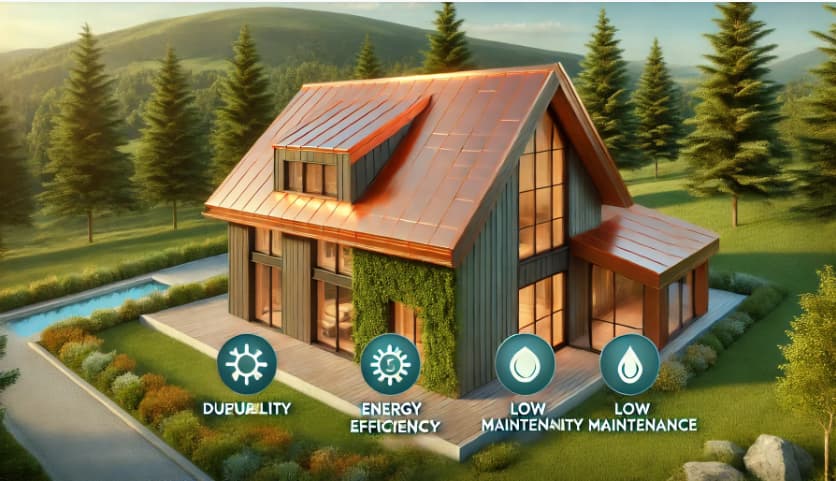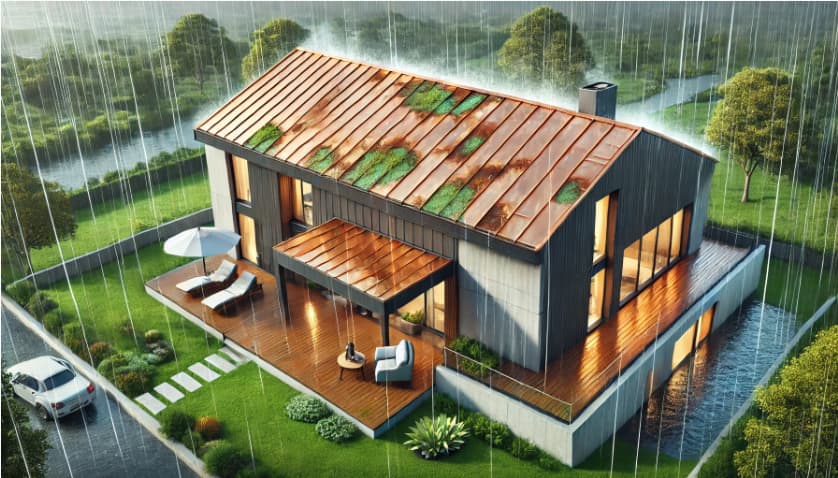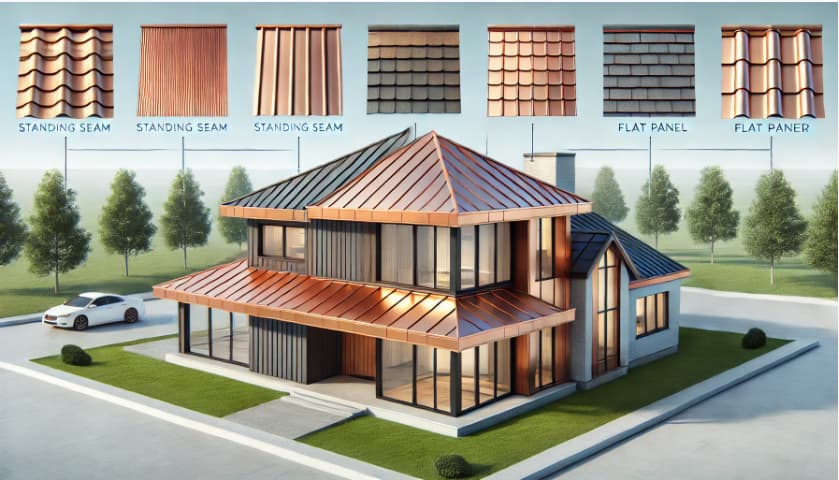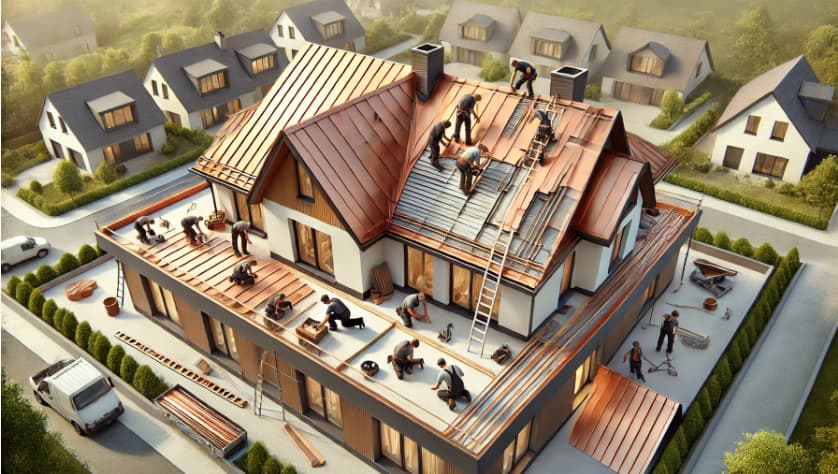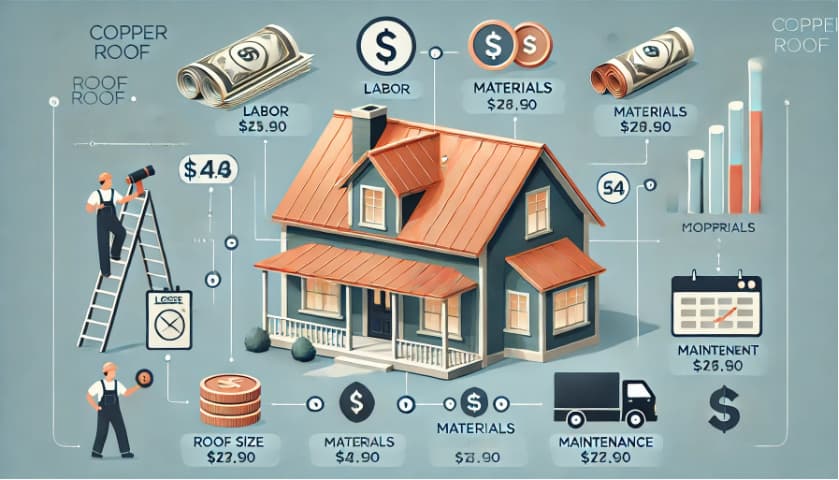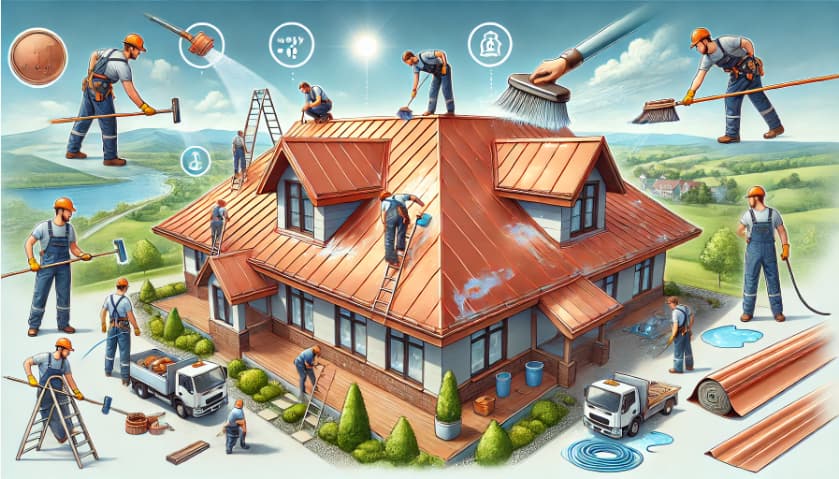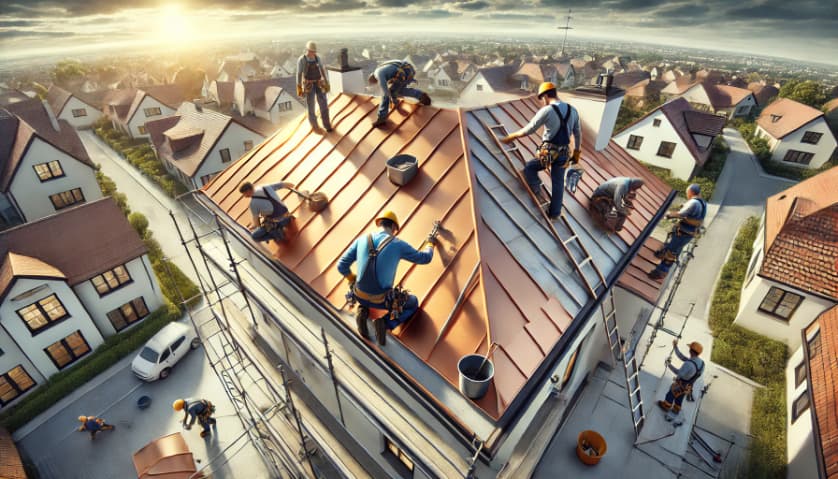Roofing
Copper Roof Installation: A Guide to Durable and Stylish Roofing
Copper roofing is a premium option that offers unmatched durability and aesthetic appeal. If you’re considering copper roof installation, it’s essential to understand both the advantages and challenges that come with this material.
Copper roofs, known for their longevity, are often seen on historical buildings, but they are increasingly popular in modern homes.
The natural weathering process of copper, which turns from shiny bronze to a green patina, adds a unique character to your home.
This comprehensive guide will walk you through everything you need to know before installing a copper roof, including the benefits, costs, installation methods, and materials used.
Not only does a copper roof installation enhance the appearance of your home, but it also increases its value due to copper’s long lifespan and minimal maintenance needs.
Whether you are planning a roofing project for a new home or upgrading an old roof, copper is a choice that lasts a lifetime. Before you decide, let’s explore what makes copper roofs a standout option.
Explore copper roofing options now. Check Here
1. What is a Copper Roof?
A copper roof consists of panels or shingles made from copper, a material that has been used for centuries. Copper roof installation is known for bringing a timeless, elegant look to any structure, whether it’s a historic landmark or a contemporary building.
As copper weathers, it develops a beautiful patina that starts with bronze tones and slowly turns to a greenish hue. This aging process makes copper roofs unique, giving your home a distinct and evolving look.
Copper roofs are becoming more common in residential buildings because of their longevity and minimal maintenance needs.
They resist corrosion, which means you won’t have to worry about rust or deterioration. Over time, your copper roof will only grow more beautiful, adding value to your home.
If you’re considering a copper roof installation, you’re investing in a durable and visually striking roofing solution that will last for generations.
Considering a copper roof? Learn more
2. Key Benefits of Copper Roofing
Copper roofs offer several significant advantages, making them a top choice for homeowners who prioritize durability and aesthetics. One of the main benefits of copper roof installation is its longevity.
Copper roofs can last more than 100 years, which is far longer than traditional roofing materials like asphalt or wood. With copper, you’ll enjoy a durable roof that requires minimal maintenance, saving you money on repairs over time.
In addition to its durability, copper is environmentally friendly. Copper is highly recyclable, and many copper roofs are made from recycled materials. This makes copper roof installation a great option for eco-conscious homeowners.
The material’s reflective properties also contribute to energy efficiency by reducing heat absorption, keeping your home cooler in the summer and lowering your energy bills.
Lastly, copper adds curb appeal. Its natural patina gives the roof a beautiful, unique look that evolves over time.
Whether your home is modern or traditional, copper can complement any architectural style, making it an excellent investment for homeowners looking to boost their property’s value.
Looking for long-lasting and eco-friendly roofing? Check out
3. Drawbacks of Copper Roofing
Although copper roofing offers numerous benefits, there are also some drawbacks to consider. The most significant disadvantage of copper roof installation is the high initial cost.
Copper is one of the most expensive roofing materials available, often costing several times more than asphalt or wood.
However, it’s important to note that while copper roofs are expensive to install, their long lifespan and minimal maintenance can save you money in the long run.
Another potential drawback is the noise. Copper roofs can be louder during rain or hailstorms compared to other materials. If you’re sensitive to noise, this could be an issue.
However, adding insulation can help reduce the sound, providing a quieter indoor environment.
Finally, copper can develop stains or fingerprints during the installation process. While these marks don’t affect the durability of the roof, they can be visually unappealing until the roof’s patina fully develops.
Despite these minor issues, copper roof installation remains a wise investment for many homeowners.
Want to explore copper roofing options? Visit
4. Types of Copper Roofing Systems
There are two primary types of copper roofing systems: standing seam panels and copper shingles. Each offers its own advantages, and the choice between them depends on your preferences and the design of your home.
Standing seam copper roofs are made from vertical panels that interlock with raised seams. These seams provide superior water resistance, making this type of copper roof installation an excellent option for areas that experience heavy rainfall.
The sleek, modern look of standing seam roofs also makes them popular among homeowners seeking a contemporary aesthetic.
On the other hand, copper shingles offer a more traditional look. They resemble asphalt shingles but are far more durable.
Copper shingles are often chosen by homeowners who want the appearance of a classic roof but with the added benefits of copper’s longevity and resistance to the elements.
Both systems have their advantages, and each can elevate the appearance of your home while providing lasting protection.
Interested in learning more about copper roofing systems? Click here to explore options.
5. Installation Process for Copper Roofing
The copper roof installation process is detailed and requires the expertise of skilled professionals. First, contractors assess the roof’s structure to ensure it can support the weight of the copper.
This is followed by preparing the roof deck, which includes removing old materials and installing a water-resistant underlayment.
The underlayment is crucial for protecting your home from moisture while the copper panels are being installed.
Once the roof is prepped, the copper panels are fabricated either on-site or pre-formed. The panels are installed from the bottom up, with each overlapping the next to create a watertight barrier.
Finally, flashings are installed around chimneys, vents, and other roof protrusions to prevent leaks.
Throughout the copper roof installation process, attention to detail is key to ensuring the roof’s durability and longevity.
Each panel must be properly aligned, and flashings must be carefully sealed to avoid water intrusion. By hiring experienced professionals, you’ll ensure that your copper roof is installed correctly and will provide reliable protection for decades.
Need expert copper roof installation? Find trusted contractors through our [affiliate link].
6. Materials and Equipment Used in Copper Roofing
Copper roofing materials are available in both soft and half-hard copper. Soft copper is more flexible, making it ideal for curved surfaces or intricate details, while half-hard copper is better suited for flat areas like valleys and ridges.
he choice of material depends on the design and complexity of the copper roof installation.
In addition to the copper sheets or shingles, specialized tools are required for installation. These include seaming tools, hammers, and metal rollers, which help to fold and secure the panels.
Proper equipment ensures that the roof is both functional and aesthetically pleasing. Investing in high-quality materials and tools is essential for a successful copper roofing project.
The tools required for copper roof installation can be expensive, but they are crucial for ensuring the roof’s longevity.
Using the right equipment ensures that the seams are tightly sealed and the panels are properly secured, which prevents leaks and extends the life of the roof.
Looking for quality materials for your copper roof? Explore your options now.
7. Costs Involved in Copper Roof Installation
The cost of copper roof installation can vary based on several factors, including the size of your roof, the complexity of the design, and labor costs in your area.
Copper is one of the most expensive roofing materials, with prices ranging from $15 to $25 per square foot.
However, the long-term savings on maintenance and energy costs often offset the initial investment.
Several factors can influence the overall cost. For instance, thicker copper sheets are more durable but also more expensive.
Similarly, if your roof has a complex design with many angles and curves, the labor costs will be higher due to the increased difficulty of installation.
Despite the high initial cost, many homeowners find that copper roof installation is a worthwhile investment.
The longevity and minimal maintenance of copper roofs mean fewer repairs and replacements, ultimately saving money over time.
Interested in finding out how much copper roof installation will cost for your home? Check out.
8. Maintenance Tips for Copper Roofs
Copper roofs are known for their low maintenance, but that doesn’t mean they don’t need any care at all.
After copper roof installation, it’s important to check the roof periodically for debris, especially in areas where leaves or branches might accumulate. Keeping the roof clean will help maintain its appearance and ensure that water flows freely off the roof.
Another key aspect of maintaining a copper roof is understanding the natural aging process. Copper develops a patina over time, which can take years to fully form.
While some homeowners love the look of a new, shiny copper roof, others prefer the green patina. Regardless of your preference, it’s important to know that this process is natural and doesn’t require any special care.
If you live in an area with frequent storms, make sure to check for any damage after severe weather. Although copper is highly durable, heavy branches or debris could potentially damage the roof.
Looking for maintenance tips for your copper roof? Learn more
9. Hiring a Professional for Copper Roof Installation
Copper roofing is not a DIY project. The complexity of copper roof installation requires skilled professionals who have experience working with metal roofing systems.
Hiring a professional ensures that the roof is installed correctly, without gaps or misaligned panels that could lead to leaks.When choosing a contractor, make sure to look for a company with experience in copper roofing.
Not all roofing contractors are familiar with the specific challenges of copper roof installation, so it’s essential to find someone with the right expertise.
Additionally, check for reviews and testimonials from previous clients to ensure the contractor’s quality of work.
The benefits of hiring a professional far outweigh the risks of attempting this project on your own. Copper roofing is a significant investment, and proper installation is key to making sure that investment pays off in the long run.
Need help finding a reliable copper roof installer? Check out
Conclusion
Copper roof installation offers homeowners a beautiful, durable, and energy-efficient roofing solution. While the initial cost may be high, the long-term benefits, including reduced maintenance and increased property value, make copper roofs a smart investment.
With proper installation and care, a copper roof can last over 100 years, providing reliable protection and adding unique character to your home.
Ready to invest in a copper roof? What do you think about the benefits and potential drawbacks?
Share your thoughts in the comments below, and don’t forget to like and share this article!🙂
Frequently Asked Questions
1. What are the disadvantages of a copper roof?
A. The main disadvantages of a copper roof are the high initial cost and the potential for noise during rain or hailstorms.
Copper is more expensive than other roofing materials, but its durability can offset this over time. Additionally, copper roofs can be noisy in bad weather, although insulation can help reduce the sound.
2. How long will a copper roof last?
A. A well-maintained copper roof can last over 100 years. Its exceptional durability makes it one of the longest-lasting roofing materials.
Copper is highly resistant to corrosion and weather, which contributes to its long lifespan. This makes it a great long-term investment for homeowners looking for minimal maintenance and repairs.
3. Is copper a good roofing material?
A. Yes, copper is an excellent roofing material due to its durability, unique aesthetic appeal, and low maintenance requirements.
It offers high resistance to the elements, develops a beautiful patina over time, and can increase your home’s value.
Though expensive upfront, copper roofs are a smart choice for those seeking a long-lasting and eco-friendly roofing solution.
Recent Posts
- How Much Does a Copper Roof Cost? Unveiling Costs, Benefits, and Key Tips
- Copper Roofing: Why Now Is the Best Time to Invest
- Does Aluminum Roof Coating Stop Leaks? The Truth Revealed
- How to Install Gutters on a Metal Roof: A Step-by-Step Guide
- How Often to Clean Gutters: Essential Maintenance Tips

